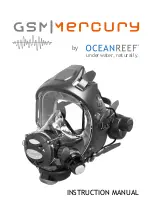
Revision 4
14
April 2020
Section 1
943-TGX-CE Tail Gas Analyzer Introduction
1.
1
Overview
The use of a
Tail Gas Analyzer
to assist in the control of combustion air to acid gas ratios in
Claus Sulfur Recovery Plants is a standard procedure in industry. The plant tail gas is analyzed
using ultraviolet spectroscopy and an output signal that corresponds to the air requirement is
determined. This observed signal is proportional to the percentage change required in the
combustion air to provide stoichiometric concentrations of the principal reactants; H
2
S and SO
2
.
When the process is optimized and the correct stoichiometric concentrations of H
2
S and SO
2
are achieved, the feedback signal (normally referred to as
Air Demand
) is zero (which means
that no change is required).
The simplified Air Demand equation is:
𝐴𝑖𝑟 𝐷𝑒𝑚𝑎𝑛𝑑 = 𝐹 × ([𝐻
2
𝑆] − 𝑅
𝑜𝑝
[𝑆𝑂
2
])
where:
F
= plant specific gain factor
[H
2
S
] = concentration of H
2
S
[SO
2
]
= concentration of SO
2
R
op
= operating ratio (typically 2)
When the ratio of stoichiometric concentration of H
2
S to SO
2
equals the
operating ratio
(R
op
),
the Air Demand output becomes zero regardless of the
plant specific gain factor
(Plant
Factor) (F). When the plant factor (F) is established for a particular process, the units of Air
Demand become ‘percent change required in process air’. (
i.e.,
a computed Air Demand of
+1.5% means that the process is 1.5% excess in air.) To achieve optimum performance of the
Claus Sulfur Recovery Plant, the Air Demand should be kept near zero.
The sample gas obtained from the sulfur plant waste or tail gas stream may also contain other
sulfur species such as COS, CS
2
, and sulfur vapour (S
vap
). These species, if present in
significant concentrations, must be analyzed for and a correction be made to avoid interference
with the H
2
S and SO
2
analysis.
1.2
Analytical Method
The analyzer uses a
spectrometer
with a diffraction grating that is optimized in the spectral
region where the species of interest, namely hydrogen sulfide (H
2
S), sulfur dioxide (SO
2
), carbon
disulfide (CS
2
), carbonyl sulfide (COS), and sulfur vapour (S
vap
) absorb (the compounds of
interest absorb between 200 and 400 nm) coupled to a detection system that maximizes
sensitivity and resolution while minimizing dark current and stray light noise. A 2048 element
CCD detector is employed to detect light across the wavelength range of interest.
The UV radiation is supplied by a highly stable deuterium broadband source and is transmitted
to/from the measurement cell via UV
fibre optic cables
. This approach provides for analytical
accuracy and allows for more precise multi-species analysis than that of a conventional
Содержание 943-TGX-CE
Страница 132: ...Revision 4 132 April 2020 Figure 81 Oven Cabinet Door Removed ...
Страница 133: ...Revision 4 133 April 2020 Figure 82 Control Cabinet Door Removed ...
Страница 134: ...Revision 4 134 April 2020 Figure 83 Power Steam Air Signals Connection Details ...
Страница 135: ...Revision 4 135 April 2020 Figure 84 AC Wiring Schematic ...
Страница 136: ...Revision 4 136 April 2020 Figure 85 DC Signals and Wiring Diagram ...
Страница 137: ...Revision 4 137 April 2020 Figure 86 Flow Diagram ...















































